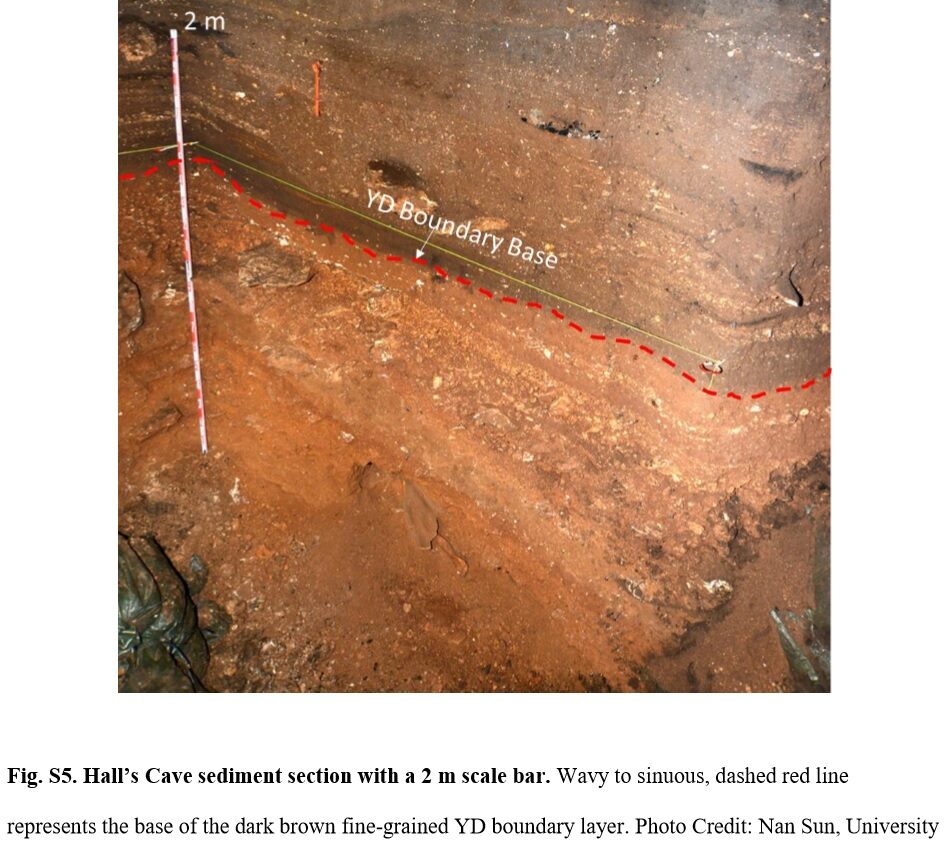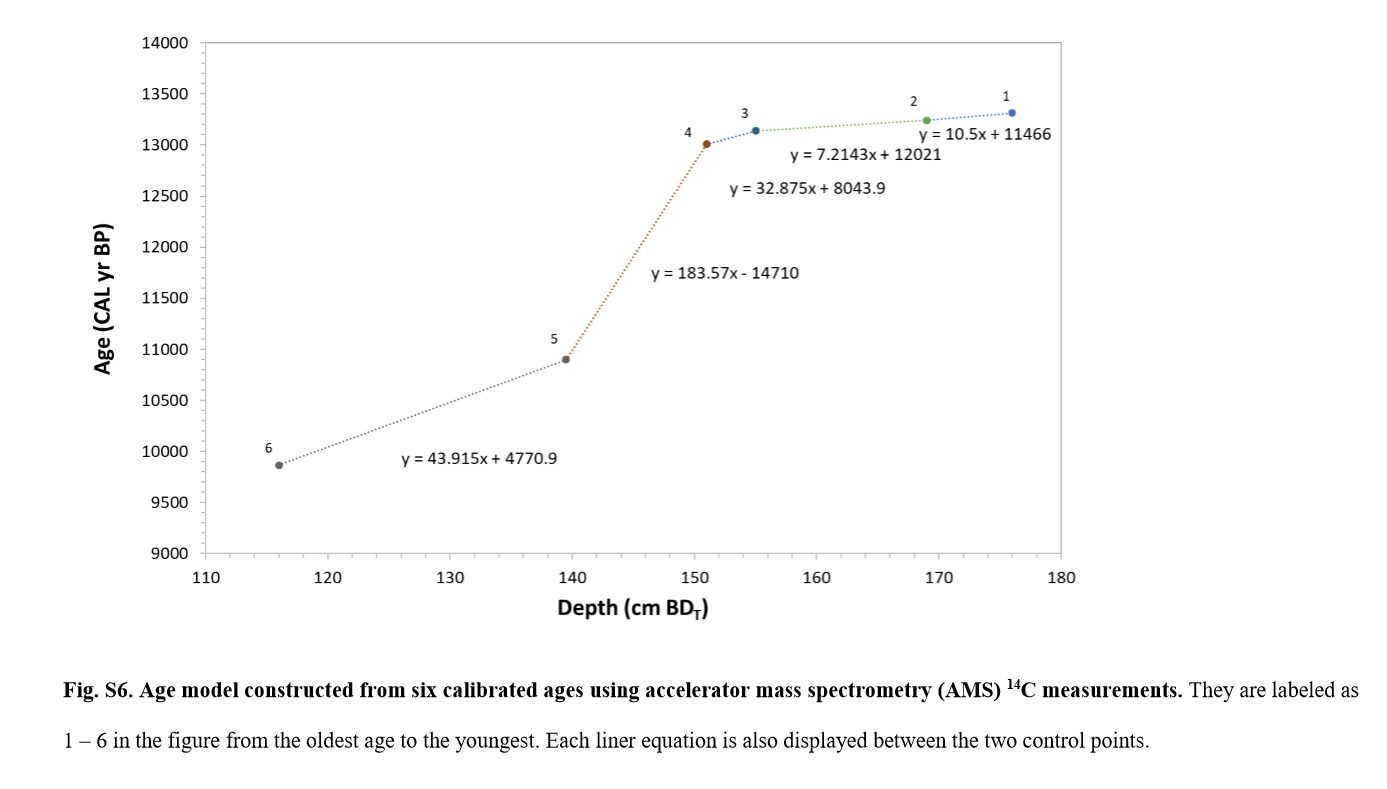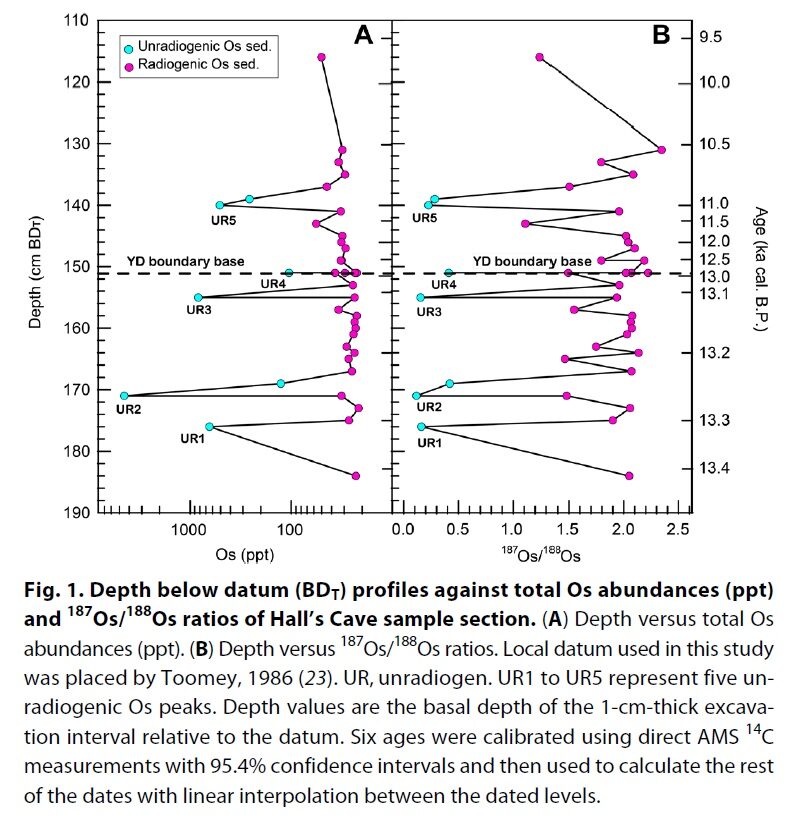On July 31
st 2020, Sun
et al. published a paper in
Science Advances [1] that suggests the Younger Dryas cooling event nearly 13000 years ago was triggered by the Laacher See volcanic eruption rather than a cosmic impact, the usual explanation.
Until now, over 60 primary peer-reviewed journal papers together with dozens of supporting responses all agree the Younger Dryas event was caused by Earth's collision with debris from a disintegrating comet. Only one paper has previously suggested it was caused by the Laacher See volcanic explosion - and that paper was thoroughly refuted only a year later.In their new paper, Sun
et al. focus on platinum group elemental abundances, and especially osmium isotope abundances and ratios, found in the sediment of Hall's Cave, Texas. The sediment in this cave, many meters deep, has accumulated over tens of thousands of years, providing a convenient record of environmental conditions near the cave over this time (see photo below). An easily visible transition in the colour of the sediment at a depth around 1.51 m signifies a dramatic change in climate, and has been suggested to indicate the onset of the Younger Dryas climate anomaly when the Northern Hemisphere experienced a sudden return to near ice-age conditions for over 1000 years. This view is supported by the discovery in this boundary layer of the same kinds of microscopic impact debris found at many other Younger Dryas boundary sites across four continents [2]. So, it appears that Hall's Cave is yet another record of this most dramatic and important cosmic impact event, thought to have reset human Cultures and extinguished many species of large animal across the globe. An event that is probably remembered by numerous extant religions, and might even have helped trigger the rise of our own civilisation [3].

© Nan Sun, University
However, the platinum group metal abundances in the sediment around the Younger Dryas boundary layer at Hall's Cave have not previously been investigated. If the prevailing view is correct, we should find anomalies in them very close to this layer, since cosmic impacts generally produce enhancements in several of these elements. For example, the dinosaur-killing Chicxulub impactor was particularly rich in iridium, and coated Earth in an iridium-rich layer of dust and debris. However, we know from analysis of the GISP2 ice core in Greenland, that the Younger Dryas impactor was instead rich in platinum.[4] Since that discovery peaks in platinum concentration within sediments have been used to locate the Younger Dryas boundary accurately at many other sites [5].
Sun
et al. focus on two platinum group metals in their new paper. They attach most importance to osmium, and the ratio of two osmium isotopes, even though the Younger Dryas impactor does not appear to be particularly rich in this rare metal. Certainly, an earlier report focused on osmium only found abundances of this metal at a few Younger Dryas boundary sites, whereas the platinum enrichment has been found at most sites investigated [6]. Fortunately, Sun
et al. also look for platinum enrichment at Hall's Cave.
Their focus on osmium is curious. While it is true that asteroids - that originate from the asteroid belt in the inner solar system - tend to be rich in osmium, and osmium enhancement is therefore a good indicator of an asteroid strike, the same is not known to be generally true for comets. Yet the prevailing model of the Younger Dryas impact involves a highly fragmented comet, not an asteroid. It seems, then, that Sun et al.'s strategy is likely to lead to confusion. We'll return to this issue later when we discuss their results.
Another complicating factor in the interpretation of Hall's Cave is that volcanic eruptions can also produce abundances of platinum group metals, since these metals are more highly concentrated in Earth's interior than its crust. So, by focussing on osmium, Sun et al. seem to be deliberately muddying the water, as osmium by itself cannot be used to distinguish between a volcanic eruption and a cosmic impact, especially if caused by a comet.
In fact, there are far better indicators and proxies for these very different events that can easily discriminate between them. Sulphates are known to be excellent in this respect, with a strong sulphate abundance clearly indicating a volcanic eruption. We know from high-resolution analysis of the GISP2 ice core that there is no significant sulphate signal at the onset of the Younger Dryas cooling [4]. Moreover, a strong sulphate spike in the GISP2 ice-core, thought to signify the Laacher See eruption, precedes the Younger Dryas climate transition by around 100 years and is not associated with any significant cooling. As the GISP2 ice core is sampled at roughly 3-year intervals, it is a much better record than Hall's Cave, which is effectively sampled at 50 to 100 year intervals.
Analysis of ancient lake-bed sediments from a lake in the Czech Republic, with approximately 10-year resolution, supports this view [7]. A layer of Laacher See tephra underlies a layer of Younger Dryas boundary microspherules at a depth in these lake sediments equivalent to a difference of around 100 years. And, again, no significant cooling is observed immediately following the tephra abundance, while significant cooling accompanies the microspherules.
Furthermore, abundances of magnetic microspherules, containing over 85% iron, have been found at the Younger Dryas boundary layer in various locations, strongly indicating a cosmic impact and contra-indicating a volcanic eruption. Quite simply, it is impossible for a volcanic eruption to produce these iron-rich particles.
The Laacher See eruption is therefore unequivocally ruled out as the cause of the Younger Dryas boundary layer. Clearly, then, the focus on osmium by Sun
et al., by itself a poor discriminator of a comet impact versus a volcanic eruption, is not useful in this debate.
So why do Sun
et al. conclude that the Younger Dryas boundary at Hall's Cave indicates the cooling event was likely caused by the Laacher See volcanic eruption instead, when we know this cannot be true? We need to look closely at their results to see how they arrived at this precarious position. Clearly, they ignored the evidence just discussed.
First, we should examine their age-depth model for the Hall's Cave sediments, buried in the supplementary materials accompanying their paper (see Fig. S6). Immediately, we see a problem, in that no error bars are provided with this data. In a technical sense, this means we can have no confidence in this model. Sun et al. suggest the change in colour at 1.51 m corresponds to the Younger Dryas boundary layer, but without error bars, their age-depth model cannot be used to corroborate that. Fortunately, from earlier work [2], we know that Younger-Dryas-like impact debris is found at this depth, so this aspect of their age-depth model is likely correct.

© Prehistory Decoded
We also see from their age-depth model that in the region of the boundary layer, 100 years corresponds to just 3 cm of sediment. In terms of the stratigraphy, then, the Laacher See volcanic explosion and Younger Dryas comet impact are expected to be separated by just 3 cm. Therefore, we should expect to find an osmium spike in the sediment between 1.54 and 1.56 m.
Examining, now, the main result of their paper (see Fig. 1 below), we do indeed see a conspicuous osmium abundance at 1.55 m, in perfect agreement with earlier work. Very likely, this corresponds to the Laacher See volcanic eruption. And yet, the authors suggest the boundary layer itself, at 1.51 m, likely corresponds to the Laacher See eruption even though we know from the GISP2 ice core and other sites, it cannot be.
To understand their mistake, we need to realise that at this depth in the sediment, and only at this depth, Sun et al. actually took 5 samples, not just 1. The five samples are all taken from between 1.51 and 1.52 m. But, we need to be careful here, because it is clear from their photo that the boundary layer in the sediment is not perfectly flat - it undulates slightly. Therefore, these laterally adjacent samples are not all measuring exactly the same timeframe - there will be small differences due to this undulation between them. And remember that each cm of sediment here corresponds to about 30 years - and the undulations appear to be stronger than that. So, we don't expect these five samples to be identical - even though they are taken from exactly the same depth.

© Prehistory Decoded
And, in fact, that's exactly what we see in their main plot (Fig. 1). The five different samples taken at 1.51 m all have different osmium abundances and ratios. And only one of them shows an osmium anomaly, indicating a cosmic impact or volcanic eruption took place at this time. We already know it was a cosmic impact, but the authors' argument for rejecting the impact scenario is that there is no abundance in platinum in this specific sample. And remember, our comet is thought to have been rich in platinum. Therefore, they conclude in favour of a volcanic eruption.
However, they are being selective, and fail to mention that one of the other samples at 1.51 m does exhibit a platinum anomaly. We only find this out by looking carefully at their raw measurements hidden in the supplementary materials.
What should we make of that? What is going on here? We know these signals don't have a volcanic origin, so an explanation in terms of a cosmic impact is required. The undulation in the cave sediments has already been mentioned. Moreover, if platinum and osmium-loaded debris from the impact took different physical pathways through the environment, which is likely because these metals have quite different physical and chemical properties, they might have arrived in the cave at different times, perhaps separated by many years. We already know from the GISP2 ice core that the main platinum signal is over 10 years 'wide', meaning platinum-laden dust settled-out from the atmosphere only very slowly. If osmium arrived at the cave more quickly, then the undulating nature of the sediment in the cave will likely lead to fluctuations in the abundances of these metals when measured at different lateral locations.
Or, perhaps instead, the platinum and osmium abundances are patchy - the so-called "nugget" effect. Essentially, clumps of these rare metals - probably bound-up inside other kinds of particle, might have been distributed unevenly across the floor of the cave shortly after the impact event. Or perhaps both explanations are correct - perhaps the undulating nature of the boundary, the different physical pathways through the environment of osmium and platinum, and the nugget effect are all in play here.
Whatever, it is perfectly clear the authors have been selective. They selected one out of five samples in which there is an osmium abundance and no platinum abundance, to conclude that the Younger Dryas climate change was caused by a volcanic explosion. They could just have easily based their conclusions on the sample with the platinum abundance, but no osmium abundance, to favour the comet impact scenario instead. Or, if we average across all 5 samples, we should conclude there is neither a platinum nor osmium abundance. And where does that leave us?
Probably, the best interpretation of this data, given the overwhelming evidence from other Younger Dryas boundary sites of a comet impact, is that there is both an osmium and a platinum anomaly at 1.51 m in Hall's Cave, supporting the comet impact scenario, and that the fluctuations in these readings are possibly caused by the above-mentioned effects. In my view this should have been their conclusion.
References:[1] N. Sun
et al., Volcanic origin for the Younger Dryas geochemical anomalies ca. 12,900 cal B.P.,
Sci. Adv. 2020; 6 : eaax8587.
[2] T.W. Stafford
et al., Testing the Younger Dryas ET impact (YDB) evidence at Hall's Cave Texas, American Geophysical Union, Fall Meeting 2009, abstract id. PP33B-08.
[3] M. Sweatman,
Prehistory Decoded (Matador, 2019).
[4] M.I. Petaev
et al., Large Pt anomaly in the Greenland ice core points to a cataclysm at the onset of Younger Dryas,
PNAS 2013; 110 : 12917.
[5] C.R. Moore
et al., Widespread platinum anomaly documented at the Younger Dryas onset in North American sedimentary sequences,
Sci. Rep. 2017; 7 : 44031.
[6] Y.Z. Wu
et al., Origin and provenance of spherules and magnetic grains at the Younger Dryas boundary,
PNAS 2013 ; 110 : E3557.
[7] G. Kletetschka
et al., Cosmic-impact event in lake sediments from Central Europe postdates the Laacher See eruption and marks onset of the Younger Dryas,
J. Geol. 2018; 126 : 561.
Where is the place of impact - or the places - and where are remains ?
"Younger Dryas Impact" is a hypothesis without factual proof.
How isotopes are created ? Ever thought about that ?